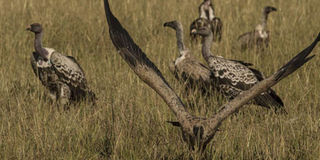Balancing vultures conservation and rights of Maasai

Vultures search for food in Masai Mara National Reserve in Kenya on August 17, 2015. Conservationists must balance vulture conservation and the socio-economic rights of the Maasai. PHOTO | BEN SOLOMON
What you need to know:
- At least Sh100 million of annual distributions from the project will also be paid into a community trust.
- Conservationists should pursue win-win dialogues for the vultures, the Maasai and energy needs for Kenyans.
Should the drive to save an endangered species of birds prevent the historically disadvantaged Maasai community from getting a guaranteed 20-year income stream from a wind energy project?
Apparently yes, say environmental groups that include Birdlife International, Nature Kenya, Kenya Bird of Prey Trust and the Peregrine Trust.
They want the project stopped ostensibly to protect endangered vultures and other bird species.
ELECTRICITY
Arbitrating the need to develop historically marginalised peoples to enable them access basic water, health, education, and a dignified life versus the legitimate need to conserve the environment needs to be properly interrogated.
The proposed Kipeto Wind Farm offers such an opportunity.
Kipeto Energy Limited has entered into a 20-year power purchase agreement with Kenya Power Ltd to supply to the national grid 100mw of electricity from a wind farm in Kipeto, Kajiado County.
COMMUNITY TRUST
As part of the implementation, the Maasai community will have been paid Sh300 million to secure land rights prior to the start of the project.
In addition, they could earn about Sh72 million in annual rental payments and have approximately 90 new homes with modern amenities including solar power built.
At least Sh100 million of annual distributions from the project will also be paid into a community trust.
These benefits will not be paid out if the environmental groups have their way.
For the Maasai of Kipeto, this proposed project is clearly a once-in-a-lifetime opportunity to break out of a vicious cycle of poverty.
LITTLE EDUCATION
Other than herding a few cows and sheep, which are subject to huge loss during drought cycles, they have no other livelihood pursuits.
The 10 or so shops that make up Esilanke Market, the epicentre of the project, only open on Thursdays – the market day.
Polygamy is the norm with an average man having three wives and 15 children.
Consequently, few of their children go beyond the only primary school in the area.
They live in mud houses and do not till the land. They walk long distances for water.
SUSTAINABLE LIVELIHOOD
Then enters Kipeto Energy Ltd. Instead of compulsorily acquiring the land, the company leased it.
For the last seven years, residents have been receiving between Sh50,000 and Sh250,000 annually depending on the land size.
They are now sending their children to secondary schools, buying clothes, building tin-roofed houses and starting to use barbed-wire fences to keep their animals safe!
The sense is that the project will bring a once in a generation chance for this community to build a sustainable livelihood if they handle their windfall income prudently.
ENDANGERED SPECIES
Then enter bird conservationists. They argue that the proposed wind farm should be stopped, as it is located in close proximity to the nesting sites of two critically endangered vulture species.
Further, that the farm is close to an important flyway for vast numbers of migratory birds.
To the conservationist, the wind turbines will pose a potential danger to the birds — and Kenya will be violating the Convention on the Conservation of Migratory Species of Wild Animals.
While in principle the debate should be on balancing the need for conservation and development, this is proving difficult in practice.
COMMUNITY INVOLVEMENT
The conservationists have not recognised the socio-economic rights of the Maasai over the Kipeto area or attempted to get their views on the project.
The bird conservationists have found their comfort zone in pushing sponsors to abandon the project on the grounds of global environment objectives.
This is in flagrant disregard of the reality that no conservation project can succeed without the support of the host community.
Abandoning the project will not automatically lead to the survival of the vultures, unless the local community’s socio-economic interests are incorporated.
HUMAN RIGHTS
There is therefore an urgent need for the environmentalists to acknowledge the need to balance vulture conservation and the socio-economic rights of the Maasai.
This position has been spearheaded by the Conservation Initiative on Human Rights, formed in 2010 by the International Union for Conservation of Nature and seven major conservation NGOs including Birdlife International.
The initiative rightfully recognises human rights as central to achieving effective and equitable conservation and development outcomes.
In her 2016 report to the UN General Assembly, the Special Rapporteur on the Rights of Indigenous Peoples Vicky Tauli Corpuz emphasised that for conservation measures to be effective, those who are most directly affected should be involved.
CONSERVATION
It is important that the efforts of bird conservation groups are informed by their commitments under international human rights norms on indigenous peoples.
They should pursue win-win dialogues for the vultures, the Maasai and energy needs for Kenyans.
Any approach that ignores the views of the historically marginalised Kipeto Maasai is more likely to lead to the disappearance rather than preservation of the vultures.
Dr Sena is a lecturer in the Faculty of Law, Egerton University, and Kenya Advocacy Officer for London-based Minority Rights Group International [email protected]




